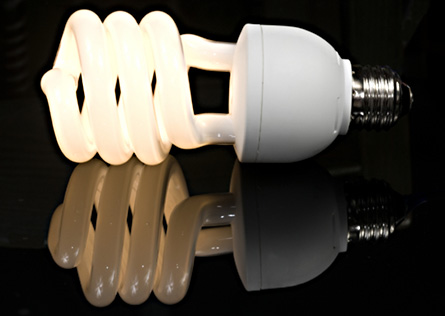Oops! A Fluorescent Light Breaks
In recent years, we’ve witnessed a big push by the feds, municipalities and green-touting enviro groups to swap out our energy-hogging lights, those filament-glowing incandescent bulbs. They’re the type that Thomas Edison commercialized little more than a decade after the Civil War. In their place we’re supposed to screw in lower-watt but equally bright compact fluorescent lights, or CFLs. The rub: CFLs rely on mercury to get their glow. And when a bulb breaks, that neurotoxic element can taint your home.

Mercury contamination can prove quite persistent. Although most of a CFL’s mercury vapor exits a broken bulb within a few days, it can impregnate surfaces and eventually reenter the air. Which brings to mind a story I wrote several years ago about attempts to diagnose the sources of high indoor mercury concentrations. Tainting in one apartment traced to mercury offgassing from a meter-square section of flooring. The most likely explanation: A thermometer broke there years earlier.
Those old thermometers typically contained about 500 milligrams of mercury; today’s CFLs contain 5 mg or less. But even the CFLs’ contents might pose concerns, at least under some circumstances, according to a report by Robert Hurt and his colleagues at Brown University in the Aug. 1 Environmental Science & Technology.
These researchers cite data from a study that released 1 mg of mercury into a 500 meter3 room to simulate a CFL break. Without ventilation, air concentrations reached 2 micrograms per m3 — or 10 times the federally recommended safe upper exposure limit for children.
So imagine now that you’re carefully carrying a handful of bulbs to install in lamps around the home and pooch gets underfoot. As you trip, those CFLs all go crashing onto a hard floor. What now?
I’ve read a lot of websites by municipal governments and even the Environmental Protection Agency. And when asked what to do about broken CFLs, most punt and simply tell consumers that the modern ones release too little mercury to pose a risk. Interestingly, they don’t even touch the issue of breakage in bigger fluorescent lights, such as the long tubes used over work benches or those ugly circular tubes needed to light some old-fashioned kitchen-ceiling fixtures. These fluorescents contain substantially more mercury than a palm-sized CFL.
More cautious websites, like EPA’s, recommend airing a mercury-tainted room for 15 minutes after a CFL breaks. Instruct family members or pets to exit the room without passing near the broken bulb. Later, scoop up visible debris with a piece of cardboard and then swab the affected area with a wet paper towel. What should you do with the debris and wet towels? EPA tells us to seal them in a plastic bag.
Actually, ditch that suggestion.
Plastic doesn’t work, Hurt told me this afternoon. Another lab found evidence that plastic wouldn’t securely trap mercury, “and we tried to confirm those results. Sure enough,” he found, “if you put a broken bulb in a plastic bag, the mercury goes right through it. It surprised me, but it’s true.” So if you bag a broken CFL and toss it in the kitchen trash can, every time you lift its lid “you’ll get a face full [of mercury].”
Hurt prefers EPA’s alternative option: Put broken CFLs in a sealed glass jar.
Where a bulb has broken on a hard surface, like a linoleum floor, EPA instructs us not to use a broom (which will become contaminated) or vacuum (which will not only become contaminated but also forcefully spew mercury vapor into the air and, potentially, other rooms).
If bulb debris ends up on carpeting, we’re to use sticky tape (like duct tape) to pick up any tiny pieces or powderlike residue. If the area must be vacuumed, EPA says to immediately empty its now-contaminated bag and pitch that into a sealed plastic bag (oops, glass jar), and immediately walk it out to the trash. (This conveniently ducks the issue of what to do with the increasingly common bagless vacuums.)
Don’t wash mercury-contaminated clothing or fabric, EPA instructs: Just pitch them out. And never dispose of CFL wastes in an incinerator chute; burning them will only release their mercury into the air.
If your bulb dies but isn’t broken, most municipalities require keeping it out of the general trash. Instead, dispose of it as hazardous waste.
So, does this sound like a cleanup for something that poses no toxic risk?
Actually, the mixed message we’ve been getting about the safety of CFLs looks like a move to downplay any mercury hazard in the interests of pushing energy conservation. I suppose most CFL proponents figure that by the time new bulbs die — after five or more years of use — someone will have figured out a long-term safety strategy for the newly mushrooming stream of CFLs entering commerce and our homes. And, actually, Hurt’s team has a new technology that might help quite a bit here (see my next post).
When I spoke with her for yesterday’s blog, Yale’s Julie Zimmerman described the CFL-mercury issue as the reverse of the “tragedy of the commons”: What’s good for society might not always be in the best interest of the individual.






